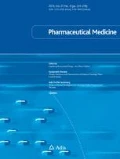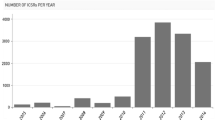Abstract
About forty years ago pharmacovigilance started as a formal public health practice with the setting up of spontaneous reporting schemes. This can be recognised as the first generation of progress in this discipline. Since then, along with the consolidation of such programmes around the world, important new developments have taken place, reinforcing our ability to identify and characterise drug safety issues earlier and on more scientific grounds.
The application of pharmacoepidemiological methods to drug safety evaluation has been crucial in this process, marking the second generation of progress. The conceptual evolution has been immense but there is still a lot of work to be done to transfer it into routine practice, in particular when the aim is to be proactive in anticipating and minimising drug safety issues. Patient risk management can be recognised as the third generation of progress and the new challenge for the first decades of the 21st century.





Similar content being viewed by others
References
Routledge P. 150 years of pharmacovigilance. Lancet 1998; 351: 1200–1
Meyboom RHB, Egberts ACG, Gribnau FWJ, et al. Pharmacovigilance in perspective. Drug Saf 1999; 21: 429–47
New member countries in the WHO Programme.The WHO Program for International Drug Monitor [online]. Available from URL: http://www.who-umc.org/index2.html [Accessed 2005 Aug 31]
Strom B. What is pharmacoepidemiology?. In: Strom BL, editor. Pharmacoepidemiology. 3rd ed. Chichester: John Wiley and Sons, 2000
Waller PC, Evans SJW. A model for the future conduct of pharmacovigilance. Pharmacoepidemiol Drug Saf 2003; 12: 17–29
Clark DW, Donnelly E, Coulter DM, et al. Linking pharmacovigilance with pharmacogenetics. Drug Saf 2004; 27: 1171–84
De Abajo FJ, Montero D, Cachá A. Pharmacovigilance: goals and strategies. Methods Find Exp Clin Pharamcol 2000; 22: 405–7
The Uppsala Monitoring Center. Expecting the worst: anticipating, preventing and managing medicinal product crises. Uppsala: Uppsala Monitoring Center, 2003
ICH E2B(M) — clinical safety data management: data elements for transmission of individual case safety reports. ICH Step 5. Note for guidance on clinical safety data management: data elements for transmission of individual case safety reports (-ICH ICSR DTD Version 2.3), November 2000 [CPMP/ICH/287/95;online]. Available from URL: http://www.emea.eu.int/pdfs/human/ich/028795en.pdf [Accessed 2005 Aug 31]
Brown E. Using MedDRA: implications for risk Management. Drug Saf 2004; 27: 591–602
Van Puijenbroek EP, Bate A, Leufkens H, et al. A comparison of measures of disproportionality for signal detection in spontaneous reporting systems for adverse drug reactions. Pharmacoepidemiol Drug Saf 2002; 11: 3–10
Wiholm BE, Olsson S, Moore N, et al. Spontaneous reporting system outside the US. In: Strom BL, editor. Pharmacoepidemiology. 3rd ed. Chichester: John Wiley and Sons, 2000
Committee for Medicinal Products for Human Use. Proposal for revision of a guideline of summary of product characteristics -2005 [Doc. Ref.: EMEA/CHMP/64302/2005; online]. London: Committee for Medicinal Products for Human Use, 2005. Available from URL: http://www.emea.eu.int/pdfs/human/regaffair/6430205en.pdf [Accessed 2005 Oct 31]
Inman WW, Vessey MP, Weterholm B, et al. Thromboembolic disease and the steroidal content of oral contraceptives: a report to the Committee on Safety of Drugs. BMJ 1970; 2: 203–9
Bateman DN, Rawlins MD, Simpson JM. Extrapyramidal reactions with metoclopramide. BMJ 1985; 291: 930–2
Chang JT, Staffa JA, Parks M, et al. Rhadomyolisis with HMG-CoA reductase inhibitors and gemfibrozil combination therapy. Pharmacoepidemiol Drug Saf 2004; 13: 417–26
Rossi AC, Hsu JP, Faich GA. Ulcerogenicity of piroxicam: an analysis of spontaneous reported data. BMJ 1987; 294: 147–50
Graham DJ, Staffa JA, Shatin D, et al. Cerivastatina Incidence of hospitalized rhabdomyolysis in patients treated with lipid-lowering drugs. JAMA 2004; 292: 2585–890
Von Kries R, Toschke AM, Strassburger K, et al. Sudden and unexpected deaths after the administration of hexavalent vaccines (diphtheria, tetanus, pertussis, poliomyelitis, hepatitis B, Haemophilius influenzae type b): is there a signal? Eur J Pediatr 2005; 164: 59–60
Arnaiz JA, Carné X, Riba N, et al. The use of evidence in Pharmacovigilance: case reports as the reference source for drug withdrawals. Eur J Clin Pharmacol 2001; 57: 89–91
Wysowsky DK, Swartz L. Adverse drug event surveillance and drug withdrawals in the United States, 1969–2002. Arch Intern Med 2005; 165: 1363–9
Shapiro S. Case-control surveillance. In: Strom BL, editor. Pharmacoepidemiology. 3rd ed. Chichester: John Wiley and Sons, 2000
Kaufman DW, Kelly JP, Levy M, Shapiro S. The drug etiology of agranulocytosis and aplastic anemia. New York: Oxford University Press, 1991
Andrade RJ, Lucena M, Fernández MC, et al. Drug-induced liver injury: an analysis of the 461 incidences submitted to the Spanish Registry over a 10-year period. Gastroenterology 2005; 129: 512–21
Alvir JM, Lieberman JA, Safferman AZ, et al. Clozapine-induced agranulocytosis: incidence and risk factors in the United States. N Engl J Med 1993; 329: 162–7
Ibanez L, Ballarin E, Vidal X, et al. Agranulocytosis associated with calcium dobesilate clinical course and risk estimation with the case-control and the casepopulation approaches. Eur J Clin Pharmacol 2000; 56: 763–7
Waller PC, Wood SM, Langman MJ, et al. Review of company postmarketing surveillance studies. BMJ 1992; 304: 1470–2
Mann RD. Prescription-event monitoring. In: Strom BL, editor. Pharmacoepidemiology. 3rd ed. Chichester: John Wiley and Sons, 2000
Hasford J, Lamprecht T. Company observational post-marketing studies: drug risk assessment and drug research in special populations: a study-based analysis. Eur J Clin Pharmacol 1998; 53: 369–71
Pérez-Zafrilla B, García del Pozo J, Aguilar-Ros A, et al. Calidad de los estudios post-autorización de tipo observacional registrados en España antes de su regulación. Med Clin (Barc) 2005. In press
EU pharmacovigilance rules for human and veterinary medicinal products (version June 2004) [online]. Available from URL: http://pharmacos.eudra.org/F2/eudralex/vol-9/home.htm [Accessed 2005 Oct 31]
Bombardier C, Laine L, Reicin A, et al., VIGOR Study Group. Comparison of upper gastrointestinal toxicity of rofecoxib and naproxen in patients with rheumatoid arthritis. VIGOR Study Group. N Engl J Med 2000; 343: 1520–8
Medicines and Healthcare Products Regulatory Agency. Summary of clinical trial data on cerebrovascular adverse events (CVAEs) in randomized clinical trials of risperidone conducted in patients with dementia. 2004 Mar [online]. Available from URL: http://www.mhra.gov.uk/home/groups/pl-p/documents/drugsafetymessage/con019490.pdf [Accessed 2005 Aug 31]
The Centers for Education and Reseach on Therapeutics (CERTs) Risk Assessment Workshop Participants. Risk Assessment of drugs, biologics and therapeutic devices: present and future issues. Pharmacoepidemiol Drug Saf 2003; 12: 653–62
Rayon P, Serrano-Castro MA, Del Barrio H, et al. Hypnotic drug use in Spain: a cross-sectional study based on a network of community pharmacies. Ann Pharmacother 1996; 30: 1092–100
Lee D, Bergman U. Studies of drug utilization. In: Strom BL, editor. Pharmacoepidemiology. 3rd ed. Chichester: John Wiley and Sons, 2000
Petri H, De Vet HCW, Naus J, et al. Prescription sequence analysis: a new and fast method for assessing certain adverse reactions of prescription drugs in large populations. Stat Med 1988; 7: 1171–5
Hallas J. Evidence of depression provoked by cardiovascular medication: a prescription sequence symmetry analysis. Epidemiology 1996; 7: 478–84
Walker AM. Observation and Inference: an introduction to the methods of epidemiology. Chestnut Hill: Epidemiology Resources Inc, 1991
Rothman KJ. Epidemiology: an introduction. Oxford: Oxford University Press, 2002
The Data Collection on Adverse Events of Anti-HIV Drugs (DAD) Study Group. Combination antiretroviral therapy and the risk of myocardial infarction. N Engl J Med 2003; 349: 1993–2003
De Abajo FJ, Montero D, García Rodríguez LA. Association between selective serotonin reuptake inhibitors and upper gastrointestinal bleeding: population based case-control study. BMJ 1999; 319: 1106–9
Dalton SO, Johansen C, Mellemkjaer L, et al. Use of selective serotonin reuptake inhibitors and risk of upper gastrointestinal tract bleeding: a population-based cohort study. Arch Intern Med 2003; 165: 59–64
De Abajo FJ, Meseguer C, Antiñolo G, et al. Labor induction with dinoprostone or oxytocin and postpartum disseminated intravascular coagulation: a hospital based case-control study. Am J Obstet Gynecol 2004; 191: 1637–43
Shapiro S. Looking to the 21st century: have we learned from our mistakes, or are we doomed to compound them? Pharmacoepidemiol Drug Saf 2004; 13: 257–65
Walker AM. Common language. Pharmacoepidemiol Drug Saf 1996; 5: 415–8
Arellano F. The withdrawal of rofecoxib. Pharmacoepidemiol Drug Saf 2005; 14: 213–7
Greenland S. Meta-analysis. In: Rothman KJ, Greenland S, editors. Modern epidemiology. 2nd ed. Philadelphia (PA): Lipincott-Raven, 1998
Hernández-Díaz S, Varas-Lorenzo C, García-Rodríguez LA. Non-steroidal antiinflammatory drugs and the risk of acute myocardial infarction. Pharmacol Toxicol 2005. In press
Gómez-Reino JJ, Carmona L, Rodríguez, et al. Treatment of rheumatoid arthritis with tumor necrosis factor inhibitors may predispose to significant increase in tuberculosis risk. Arthritis Rheum 2003; 48: 2122–7
García Rodríguez LA, Pérez Gutthann S. Use of the UK General Practice Research Database for pharmacoepidemiology. Br J Clin Pharmacol 1998; 45: 419–25
Tsintis P, La Mache E. CIOMS and ICH initiatives in pharmacovigilance and risk management. Drug Saf 2004; 27: 509–17
Committee for Medicinal Products for Human Use. Guideline on risk management systems of medicinal products for human use (draft; 2005 Jul) [online]. Available from URL: http://www.emea.eu.int/pdfs/human/euleg/9626805en.pdf [Accessed 2005 Sep 13]
US Food and Drug Administration. Guidance for industry: good pharmacovigilance practices and pharmacoepidemiologic assessment [online]. Available from URL: http://www.fda.gov/cber/gdlns/pharmacovig.htm [Accessed 2005 Aug 31]
International Society for Pharmacoepidemiology. Guidelines for good pharmacoepidemiology practices (GPP) [online]. Available from URL: http://www.pharmacoepi.org/resources/guidelines_08027.cfm [Accessed 2005 Aug 31]
ICH E2E: pharmacovigilance planning. ICH Step 4: note for guidance on planning pharmacovigilance activities (CPMP/ICH/5716/03; Dec 2004) [online]. Available from URL: http://www.emea.eu.int/pdfs/human/ich/571603en.pdf[Accessed 2005 Aug 31]
Acknowledgements
The author wishes to thank Luis A. García Rodríguez, Dolores Montero and Mariano Madurga for their useful comments. The author would also like to thank the peer reviewers who refereed this paper.
The author is an employee of the Spanish Agency for Medicines and Healthcare Products. The views expressed are those of the author and not necessarily those of the Agency.
Author information
Authors and Affiliations
Corresponding author
Rights and permissions
About this article
Cite this article
de Abajo, F.J. Improving Pharmacovigilance Beyond Spontaneous Reporting. Int J Pharm Med 19, 209–218 (2005). https://doi.org/10.2165/00124363-200519040-00002
Published:
Issue Date:
DOI: https://doi.org/10.2165/00124363-200519040-00002




